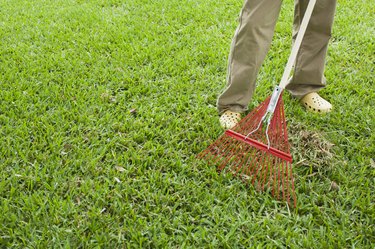
A thin layer of thatch in the lawn is natural and not harmful to the grass, but if that layer gets too thick, it makes it harder for the grass to absorb water and nutrients. Dethatching the lawn with a thatch rake is an easy way to improve the lawn's health without adding chemicals. A manually operated thatch rake works well for a small lawn or small area, but if the project seems too laborious, a power thatching rake does the job.
What Is Thatch?
Video of the Day
Thatch is a layer of light brown living and dead plant matter just above the soil level and tangled among the growing grass. It's made up of some decaying grass and other plant matter, but it's important to know whether the thatch is an issue or not. During the growing season, cut a small wedge out of the lawn using a sharp garden trowel to see how thick the thatch layer is before you decide to dethatch the lawn. If that layer is 1 to 2 inches thick according to Pennington, it's too thick, but if it's only 1/2" thick or so, there's no need to dethatch. Press that cut wedge of lawn back into position and it will still grow.
Video of the Day
The thickness of the thatch matters because the thicker it is, the harder it is for water and nutrients to reach the lawn's roots. The lawn won't look as green as it should, and it may feel spongy when walking atop the areas of thick thatch. The individual grass blades may also seem thinner and not as healthy as they should. Though the thatch eventually decomposes on its own, the lawn suffers in the meantime and more thatch buildup may occur.
Thatch Rakes Vs. Garden Rakes
Though a garden rake is strong enough for dethatching, it's not designed for that purpose. Running the garden rake through the grass removes some thatch, but it won't do nearly as good a job as a thatch rake. Using a garden rake for thatch is like using a comb made for human hair to remove matted or shedding fur from a dog; it may work a little, but not nearly as well as using a dog-grooming comb.
A thatch rake has a number of short, arced tines. Flipping the rake one way offers straight tines for thatch removal, while flipping it the other way utilizes tines that are curved slightly to the side, which helps cultivate soil after dethatching. The head of a thatch rake is adjusted by loosening a thumb screw to change the angle of the rake head. The more perpendicular the rake tines are to the soil when you use the rake, the more aggressively the tool dethatches. It's best to start with a slighter angle until you get used to how the tool works to avoid damaging the lawn or overworking your upper body.
Using a Thatch Rake
Run the rake back and forth over a small area of lawn several times while standing in one spot. The motion resembles vacuuming a bit more than it does using a typical rake only on the draw stroke. While the thatch rake technically removes the thatch only as you draw the rake towards you, pushing it away from you loosens the removed thatch from the rake tines so you don't have to manually pull the matter off the tines every minute or two.
Rake each area back and forth enough to remove some, but not all, of the thatch. A little thatch, such as 1/2" thick or less, is good for the lawn because it helps the soil retain moisture. Dethatch when the lawn isn't dormant. In the northern half of the United States, dethatch in early spring or autumn. In the southern half, dethatch in late spring through early summer. If dethatching proves too difficult or your yard is large, buy or rent a power thatch rake and use that to make the job easier.
Use a regular lawn and leaf rake to pick up the removed thatch. Deposit the clippings into a compost pile or into lawn and leaf bags for collection. It's important to remove the old thatch from the surface of the lawn to prevent it from accumulating at the thatch layer again.